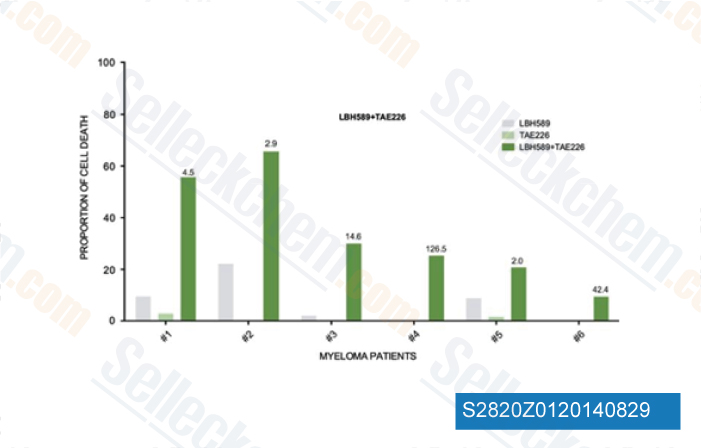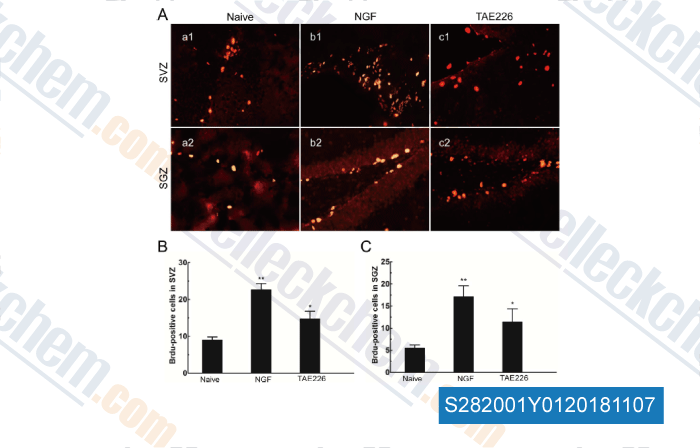|
Toll Free: (877) 796-6397 -- USA and Canada only -- |
Fax: +1-832-582-8590 Orders: +1-832-582-8158 |
Tech Support: +1-832-582-8158 Ext:3 Please provide your Order Number in the email. |
Technical Data
| Formula | C23H25ClN6O3 |
||||||
| Molecular Weight | 468.94 | CAS No. | 761437-28-9 | ||||
| Solubility (25°C)* | In vitro | DMSO | 47 mg/mL (100.22 mM) | ||||
| Water | Insoluble | ||||||
| Ethanol | Insoluble | ||||||
| In vivo (Add solvents to the product individually and in order) |
|
||||||
|
* <1 mg/ml means slightly soluble or insoluble. * Please note that Selleck tests the solubility of all compounds in-house, and the actual solubility may differ slightly from published values. This is normal and is due to slight batch-to-batch variations. * Room temperature shipping (Stability testing shows this product can be shipped without any cooling measures.) |
|||||||
Preparing Stock Solutions
Biological Activity
| Description | TAE226 (NVP-TAE226) is a potent FAK inhibitor with IC50 of 5.5 nM and modestly potent to Pyk2, ~10- to 100-fold less potent against InsR, IGF-1R, ALK, and c-Met. TAE226 (NVP-TAE226) induces apoptosis. | |||||||||||
|---|---|---|---|---|---|---|---|---|---|---|---|---|
| Targets |
|
|||||||||||
| In vitro | NVP-TAE226 (< 1 μM) inhibits extracellular matrix-induced autophosphorylation of FAK (Tyr397) in serum-starved U87 cells. NVP-TAE226 (< 1 μM) also inhibits IGF-I-induced phosphorylation of IGF-1R and activity of its downstream target genes such as MAPK and Akt in both U87 and U251 cells. NVP-TAE226 (<10 μM) retards tumor cell growth and attenuats G(2)-M cell cycle progression associated with a decrease in cyclin B1 and phosphorylated cdc2 (Tyr15) protein expression in both U87 and U251 cells. NVP-TAE226 (1 μM) inhibits tumor cell invasion by at least 50% compared with the control in an in vitro Matrigel invasion assay in glioma cell lines. NVP-TAE226 (1 μM) treatment of glioma cell lines containing wild-type p53 mainly exhibits G(2)-M arrest, whereas glioma cell lines bearing mutant p53 undergoes apoptosis, as evidence by detection of caspase-3/7 activation and poly(ADP-ribose) polymerase cleavage and by an Annexin V apoptosis assay. [1] NVP-TAE226 (5 μM) inhibits phosphorylation of FAK in the human neuroblastoma cell line SK-N-AS. NVP-TAE226 (<10 μM) treatment of the human neuroblastoma cell line SK-N-AS leads to decrease in cellular viability, cell cycle arrest, and an increase in apoptosis. [2] NVP-TAE226 (0.1 μM-10 μM) inhibits tube formation of HMEC1 cells. [3] | |||||||||||
| In vivo | NVP-TAE226 (75 mg/kg) significantly increases the survival rate of mice bearing intracranial glioma xenografts. [1] NVP-TAE226 (100 mg/kg, oral) exerts significant decrease in microvessel density in a human colon cancer model in SCID mice. [3] NVP-TAE226 (100 mg/kg, oral) efficiently inhibits MIA PaCa-2 human pancreatic tumor growth without body weight loss in vivo model. [4] NVP-TAE226 inhibits 4T1 murine breast tumor growth and metastasis to the lung in a dose-dependent manner in vivo model, associated with inhibition of FAK autophosphorylation at Y397 and Akt phosphorylation at Serine473. [5] |
Protocol (from reference)
| Cell Assay:[1] |
|
|---|---|
| Animal Study:[1] |
|
References
Customer Product Validation

-
Data from [Cell Death Dis, 2014, 5, e1134]

-
Data from [Data independently produced by , , J Inorg Biochem, 2016, 160:225-35]

-
Data from [Data independently produced by , , Neurosci Lett, 2018, 672:96-102]
Selleck's TAE226 (NVP-TAE226) has been cited by 24 publications
| Overexpression of BACH1 mediated by IGF2 facilitates hepatocellular carcinoma growth and metastasis via IGF1R and PTK2 [ Theranostics, 2022, 12(3):1097-1116] | PubMed: 35154476 |
| Mechanical coupling of supracellular stress amplification and tissue fluidization during exit from quiescence [ Proc Natl Acad Sci U S A, 2022, 119(32):e2201328119] | PubMed: 35914175 |
| Integrin αvβ3 Induces HSP90 Inhibitor Resistance via FAK Activation in KRAS-Mutant Non-Small Cell Lung Cancer [ Cancer Res Treat, 2022, 54(3):767-781] | PubMed: 34607394 |
| Three subtypes of lung cancer fibroblasts define distinct therapeutic paradigms [ Cancer Cell, 2021, S1535-6108(21)00492-X] | PubMed: 34624218 |
| TLR4 signalling via Piezo1 engages and enhances the macrophage mediated host response during bacterial infection [ Nat Commun, 2021, 12(1):3519] | PubMed: 34112781 |
| Focal adhesion kinase inhibition synergizes with nab-paclitaxel to target pancreatic ductal adenocarcinoma [ J Exp Clin Cancer Res, 2021, 91-2021)] | PubMed: None |
| Focal adhesion kinase inhibition synergizes with nab-paclitaxel to target pancreatic ductal adenocarcinoma [ J Exp Clin Cancer Res, 2021, 40(1):91] | PubMed: 33750427 |
| A first-in-class anticancer dual HDAC2/FAK inhibitors bearing hydroxamates/benzamides capped by pyridinyl-1,2,4-triazoles [ Eur J Med Chem, 2021, 222:113569] | PubMed: 34111829 |
| Campylobacter jejuni Triggers Signaling through Host Cell Focal Adhesions To Inhibit Cell Motility [ mBio, 2021, 12(4):e0149421] | PubMed: 34425711 |
| Modulation of Akt vs Stat3 activity by the focal adhesion kinase in non-neoplastic mouse fibroblasts [ Exp Cell Res, 2021, S0014-4827(21)00133-6] | PubMed: 33957118 |
RETURN POLICY
Selleck Chemical’s Unconditional Return Policy ensures a smooth online shopping experience for our customers. If you are in any way unsatisfied with your purchase, you may return any item(s) within 7 days of receiving it. In the event of product quality issues, either protocol related or product related problems, you may return any item(s) within 365 days from the original purchase date. Please follow the instructions below when returning products.
SHIPPING AND STORAGE
Selleck products are transported at room temperature. If you receive the product at room temperature, please rest assured, the Selleck Quality Inspection Department has conducted experiments to verify that the normal temperature placement of one month will not affect the biological activity of powder products. After collecting, please store the product according to the requirements described in the datasheet. Most Selleck products are stable under the recommended conditions.
NOT FOR HUMAN, VETERINARY DIAGNOSTIC OR THERAPEUTIC USE.
